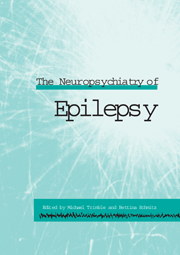Book contents
- Frontmatter
- Contents
- List of contributors
- Part I Background
- Part II Clinical aspects
- 4 The psychiatry of idiopathic generalized epilepsy
- 5 Epilepsy and learning disorders
- 6 Subtle cognitive and behavioural effects of epilepsy
- 7 Aggression and epilepsy
- 8 Epilepsy and suicide: a neuropsychiatric analysis
- 9 Postictal psychoses, revisited
- Part III Cognitive aspects
- Part IV Nonepileptic attacks
- Part V Treatment complications
- Part VI Treatment
- Index
4 - The psychiatry of idiopathic generalized epilepsy
Published online by Cambridge University Press: 05 October 2010
- Frontmatter
- Contents
- List of contributors
- Part I Background
- Part II Clinical aspects
- 4 The psychiatry of idiopathic generalized epilepsy
- 5 Epilepsy and learning disorders
- 6 Subtle cognitive and behavioural effects of epilepsy
- 7 Aggression and epilepsy
- 8 Epilepsy and suicide: a neuropsychiatric analysis
- 9 Postictal psychoses, revisited
- Part III Cognitive aspects
- Part IV Nonepileptic attacks
- Part V Treatment complications
- Part VI Treatment
- Index
Summary
‘Temporal Lobe Epilepsy (TLE) is associated with an increase in psychiatric morbidity compared to other types of epilepsy.’ This hypothesis is central to the discussion of the relationship between epilepsy and psychopathology, according to the statement of Anne Stub-Naylor, a young Danish doctor, in her thesis on ‘Epilepsy and psychiatric disorder – a comorbidity study’ (1996). And she continues: ‘ Despite the scarce evidence it appears to have become a dogma that such a relationship exists. In “ contemporary ” medicine especially three “ schools ” have nourished this view, represented by Elliot Slater, David Bear and Michael Trimble’. Indeed, the description of schizophrenia-like psychoses in patients with TLE (Slater et al., 1963) – has encouraged the expectation of finding a biological-based explanation for schizophrenia. For this reason, the discussions on psychiatric disorder and especially those on psychoses in the case of epilepsy have long been dominated by the ‘ limbic hypothesis ’. It seems that the time has come to take a critical look at the above thesis, because the understanding that other forms of epilepsy also show a clinical profile and a biological quality is gaining ground. To have a stake in biological psychiatry, the psychiatric aspects should be taken into consideration in regard to other forms and syndromes of epilepsy as well. For the following reasons, the syndromes of idiopathic generalized epilepsy (IGE) are especially suitable for consideration. Grouped together they are at least as frequent as the localization-related temporal and extra-temporal epilepsies.
- Type
- Chapter
- Information
- The Neuropsychiatry of Epilepsy , pp. 41 - 61Publisher: Cambridge University PressPrint publication year: 2002
- 12
- Cited by

